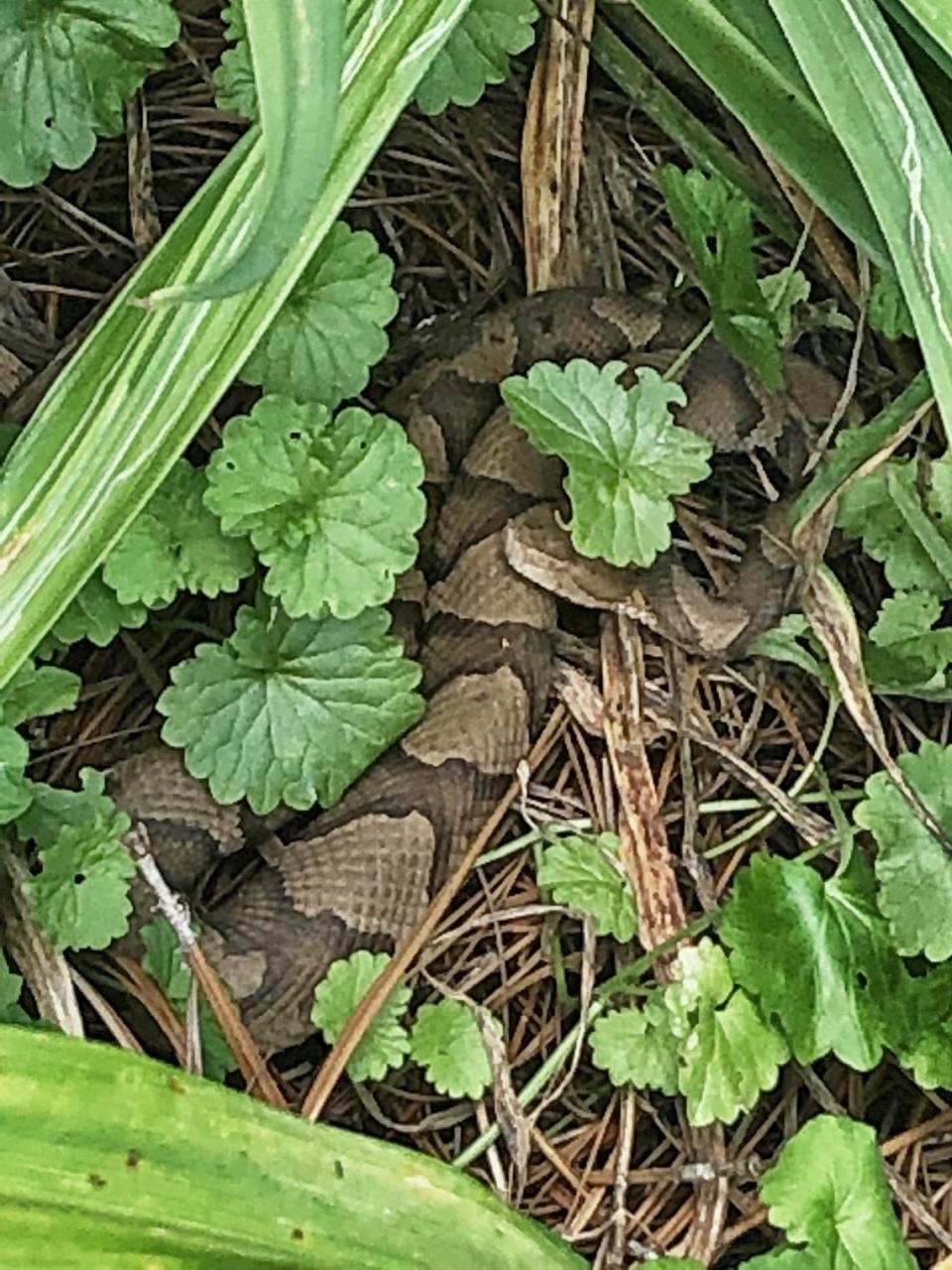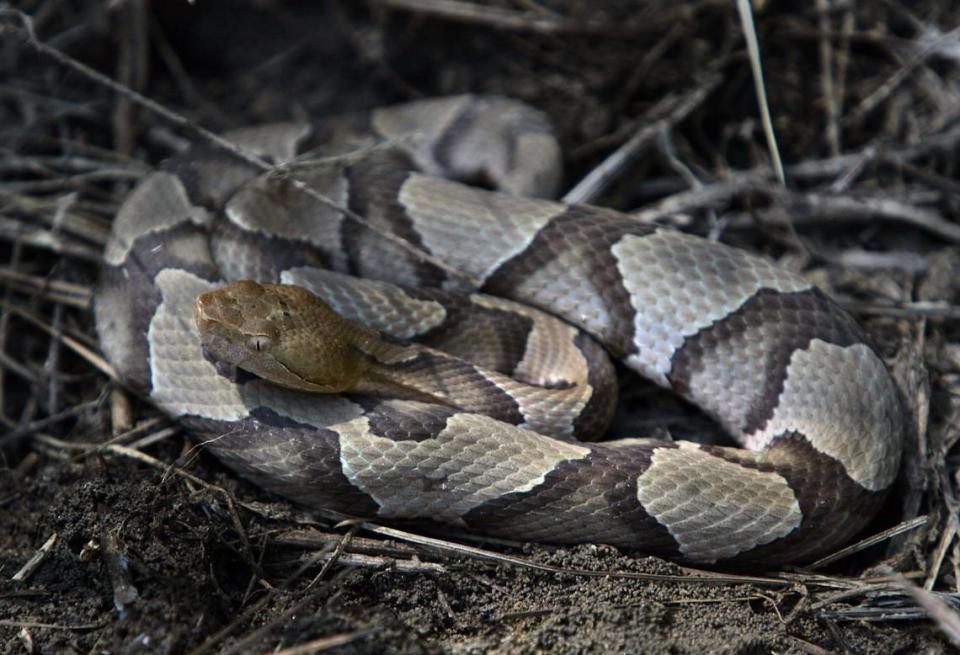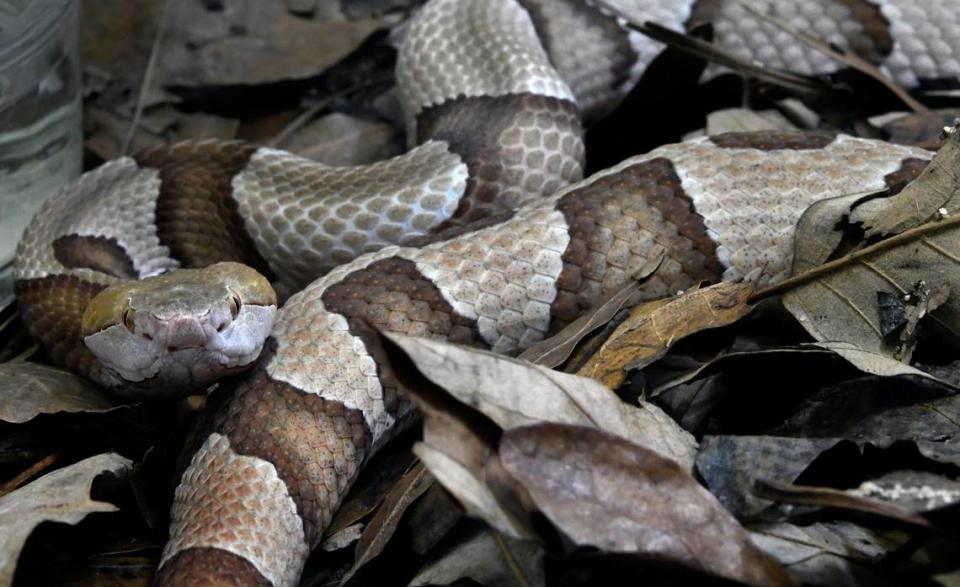It’s ‘baby copperhead season’ — what to know about NC’s most common venomous snake
Copperheads, the most prevalent venomous snakes in North Carolina, start making themselves known each year in the spring, just as the weather starts to warm up.
The seemingly ubiquitous slitherers enjoy our long summers and all of our warm, humid weather.
And right about now — just when most of us are looking toward summer’s end — is the time of year when copperheads start to multiply.
Since it’s always a good time to learn more about the wildlife we share our spaces with, here’s what you need to know about baby copperhead snakes, where copperheads are more likely to hang out, and of course, how to avoid them.
Copperheads are born late summer through early fall
Baby copperheads are mostly born in late August or early September, but a few may be born as early as mid-August or as late as early October, Jeff Beane, herpetology collection manager at the N.C. Museum of Natural Science in Raleigh, told The News & Observer in a previous report on copperhead snakes.
“Weather, geography, region and other factors can influence the exact time of birth,” Beane said. “But usually the last few days of August and the first few of September are peak for copperheads.”
Copperheads are born, not hatched
Copperhead babies are born live, they do not hatch from eggs.
According to the North Carolina Wildlife Resources Commission, female copperheads can have one litter per year, and the litters can range from 2 to 18 snakes, which are 8 to 10 inches long when born.
Juvenile copperheads have colorful tails
Newly born or very young copperheads will resemble their parents — except they’ll have a bright yellow or greenish-tipped tail that darkens pretty quickly.
Is a baby copperhead bite more dangerous?
You’ll often hear that a bite from a baby copperhead is more dangerous than the bite from an adult, because the baby can’t control the amount of venom it uses.
When we asked Beane about that, his answer was: “It’s a little bit complicated.”
Beane confirmed that young copperheads may be less likely to control or withhold the amount of venom they inject, but that they also don’t have as much venom as a mature snake.
Here are some points to consider.
▪ Defensive bites vs. prey-seeking bites. A copperhead will bite for two reasons: to kill and eat prey or to defend itself.
Beane explained that when striking prey to kill it and eat it, a baby copperhead will inject as much venom as necessary in order to achieve that goal. When a copperhead bites a human, that’s a defensive bite, and the snake isn’t likely to use as much venom in those cases (or sometimes, no venom at all).
“It is not advantageous for snakes to waste venom — it’s metabolically expensive to make, so they don’t want to bite anything other than prey items,” Beane said.
Beane notes that whenever a snake bites, it’s an instinctive response, and that the snake doesn’t “reason it out.” But, since a snake’s number one reason for biting is to kill and eat prey, snakes only bite people in an act of self-defense, Beane said.
“They would be unlikely to mistake something 100 times their size as a prey item,” Beane said.
▪ More concentrated venom? Beane told us that a newborn’s venom “may or may not be slightly more concentrated than adult’s,” but that because a larger copperhead has a lot more venom to inject, the larger snake would probably more than make up for any differences in chemical composition.
Plus, Beane said, a larger or more mature copperhead has longer fangs, which can penetrate a sock or thick skin, so it has more “delivery capacity” than a juvenile snake.
A mature copperhead can also “strike a greater distance and with more force and accuracy,” said Beane.
▪ Baby copperhead bites just aren’t as common. Most bites from copperheads on humans seem to be from adults, Beane said.
“I don’t hear much about people being bitten by newborns,” Bean said. “Personally, if I had to choose being bitten by a newborn copperhead or an adult, I would choose a newborn because of the potentially much smaller quantity of venom.”
▪ Bites are are rarely fatal. According to the Carolinas Poison Center, copperhead bites can be “severe,” but generally are not as bad as bites from other venomous North Carolina snakes. About half of all copperhead bites result in only mild swelling and pain, according to the center.
Call the Carolinas Poison Center at 1-800-222-1222 if you are bitten by a snake.

How to avoid copperhead snakes
Even though copperhead bites are rarely fatal, it’s best to use caution when working or playing outdoors, especially in areas where snakes are more likely to be hanging out.
The best way to not get bitten by a copperhead is to understand their habits and recognize that they may be encountered anywhere there is potential habitat.
▪ What are snake habitats? Copperheads love pine straw, dried leaves or brush, or dense, low-growing ground cover like English ivy. They also love wood piles and dry stack walls, which are border walls that are essentially stacked pieces of slate without mortar — those crevices make great homes for prey.
From Beane: “Common sense things like not putting your body parts into places you can’t see, not walking barefoot at night, not walking barefoot in thick vegetation, using a flashlight at night, not sticking your hands up underneath wood piles, watching what you are doing at all times, watching where you put your hands and feet will prevent the great majority of bites.”

▪ Where is snake prey? Copperheads love to eat rodents, shrews, lizards, snakes, frogs and salamanders, and even insects, such as large caterpillars and cicada nymphs. So know that anywhere you might see those creatures, you could also see a snake.
▪ Be more cautious at night. Copperheads are active during the day or night time, but are largely nocturnal during hot weather, says NC Wildlife, so use more caution at dusk or dark. Try to let the dogs out before dark, and if you need to run out at night to take out the trash, skip the flip-flops and wear shoes that cover your feet.
▪ Leave them alone. While many bites occur when someone inadvertently puts a hand or foot near a copperhead, NC Wildlife notes that a large percentage of bites occur when a person is trying to kill or remove a copperhead.
The best thing to do if you encounter a copperhead is to leave the snake alone.
“Admire them from a safe distance and leave them alone,” Beane said. “Many bites and other injuries have occurred while people were attempting to kill snakes. No one was ever bitten by a snake while they were leaving it alone.”
If leaving it alone makes you nervous, you can always call a professional wildlife relocation expert to remove the snake from your yard.

Know what a copperhead looks like
Copperheads are brownish in color with an hourglass-shaped pattern on their backs, which resembles a Hershey Kiss.
However, Talena Chavis, owner of NC Snake Catcher (facebook.com/ncsnakecatcher) in Cary, said it can be tricky to rely just on markings, especially if you haven’t seen many copperheads in person or you only caught a quick glimpse of it.
“There can be a lot of variation in color and pattern with flecks and specks between the kisses,” Chavis tells The N&O.
If you see a snake in your yard and you’re not sure if it’s a copperhead (or other venomous snake), Chavis recommends taking a photo (from a safe distance) and having the identity confirmed by an expert.
In addition to professional relocation services and yard inspections and evaluations, Chavis can identify snakes by photos texted to 919-867-0173.
Chavis says that all of the snakes she captures are humanely relocated to an area where she has permission to release them.

